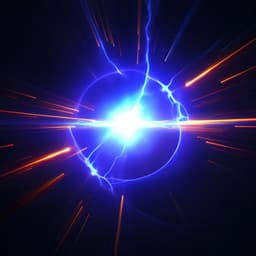
Physics
Shaped liquid drops generate MeV temperature electron beams with millijoule class laser
A. Mondal, R. Sabui, et al.
Discover how researchers, including Angana Mondal and Ratul Sabui, have harnessed non-relativistic laser intensities to generate MeV temperature electrons using dynamic target structuring of micro-droplets. This innovative approach paves the way for efficient compact, ultra-fast electron sources, demonstrating significant advancements in electron radiography.
~3 min • Beginner • English
Introduction
The study addresses how to generate relativistic-temperature (≥0.5 MeV) electrons using non-relativistic laser intensities (~10^16 W cm−2) and compact, high-repetition-rate, millijoule-class femtosecond lasers. Conventional approaches like laser wakefield acceleration (LWFA) typically require higher intensities (~10^18 W cm−2) for efficient acceleration; at moderate intensities (~10^17 W cm−2) LWFA becomes inefficient due to limited acceleration gradients. Prior demonstrations using mJ-class, kHz lasers achieved electron energies up to ~1.5 MeV in gas jets but at higher intensities or specialized focusing. The purpose here is to devise a strategy that leverages parametric instabilities and target micro-structuring to reduce the required laser intensity by ~100× relative to ponderomotive expectations, enabling compact ultrafast electron sources. The central hypothesis is that dynamically shaping a micro-droplet to form a concave, plasma-filled cup with an optimized density gradient enables oblique-incidence two-plasmon decay (TPD) with ultrashort (25 fs) pulses, thereby generating directed electron beams with hot temperatures of ~200 keV and ~1 MeV at only 4 × 10^16 W cm−2.
Literature Review
- LWFA has been successful for MeV–GeV electrons but typically requires high intensities (~10^18 W cm−2); at ~10^17 W cm−2 gradients reduce to a few GV/m and efficiency drops. Demonstrations with mJ, kHz lasers achieved 100 keV quasi-monoenergetic beams at ~3 × 10^18 W cm−2 and up to 1.5 MeV with ~10 mJ pulses and tight focusing.
- Target modification approaches (e.g., nanostructures, micro-targets) have enhanced absorption/acceleration but have not efficiently produced relativistic electrons with moderate-intensity table-top lasers.
- Parametric instabilities like TPD and SRS have historically been driven with long (ps) pulses and higher energies (≥100 mJ) to reach 10^15–10^16 W cm−2; with ultrashort (25–40 fs) pulses and steep gradients, TPD has been inefficient, typically yielding T_hot ~150 keV even near 10^18 W cm−2.
- Oblique incidence can lower TPD thresholds by sampling longer effective scale lengths; however, conventional flat targets with ultrafast pulses seldom achieve the required conditions. This work departs by using dynamic, in-situ droplet shaping to realize oblique-incidence TPD with mJ, ≤100 fs pulses.
Methodology
Experimental setup:
- Laser: 800 nm Ti:Sapphire, 25 fs, 1 kHz, pulse energy up to 2 mJ; focused to 11 µm waist yielding on-target intensity 4 × 10^16 W cm−2.
- Target: Methanol micro-droplets of 15 µm diameter generated from a 10 µm jet at 1 MHz (20 bar), in 5 × 10^−2 mbar vacuum.
- Two-pulse collinear scheme: a pre-pulse at 5% of main pulse energy arrives 4 ns before the main pulse. Polarization controlled with a half-wave plate; pre-pulse energy scanned (0–~10%) via beam splitter and polarizer/HWP to optimize effects.
- Diagnostics:
- Electron spectroscopy: magnetic electron spectrometer (0.11 T) with either LANEX (200 keV–1 MeV, 8 s exposures via 8-bit CCD with 540 nm filter) or BAS-MS imaging plates (IP) for >1 MeV over longer acquisition (~900 s). Position-to-energy calibration performed using measured magnet profile and geometry; detector response corrections applied.
- Angular distribution: IPs arranged azimuthally (0–360°) and polar (−40° to 40°) at 3.2 cm; 110 µm Al shielding; exposures ~30 s; laser entry/exit apertures provided.
- X-rays: MINIPIX (≤300 keV) and NaI(Tl)+MCA (100 keV–6 MeV); 6 mm Pb filter to avoid pile-up; gated to main pulse; calibration with standard sources; spectra fitted to Maxwell-Boltzmann to infer electron temperatures.
- Optical: back-reflected direction spectrometer; supercontinuum background measured by misalignment and subtracted; search for 3/2 ω (≈532 nm) emission signature of TPD/SRS.
- Shadowgraphy: split beam into P1 (8%) and P2 (92%); P1 mimics pre-pulse on droplet, P2 frequency-doubled to 400 nm to image transverse target morphology at controlled delays (2.6–6 ns) using a gated CCD with 400 nm bandpass.
Numerical modeling:
- 2D radiation-hydrodynamics (h2d): Methanol droplet (radius 7.5 µm, density 0.792 g cm−3); pre-pulse: 800 nm, 0.1 mJ, 25 fs (sech^2), 11 µm FWHM spatial; ray-traced focusing; intensity ~0.2 × 10^16 W cm−2 (≈5% main). Simulated to 4 ns after pre-pulse; outputs concave cup formation and underdense plasma gradient. Derived underdense plasma scale length L ≈ 8.6 ± 0.1 µm from exponential fit.
- 2D PIC (SMILEI and EPOCH): box 100λ × 100λ, 3000 × 3000 cells; droplet centered; 49 macro-particles per cell; ions stationary (EPOCH also includes ionization with neutral Ar background at 10^19 cm−3). Laser: Gaussian transverse with waist W0 = 12λ, a0 ≈ 0.2, 24.3 fs FWHM, peak intensity ≈8.56 × 10^16 W cm−2; incidence along x, polarization along y. Virtual circular detector records energy and angles. Density profiles modeled for spherical and cup-like targets; plasma scale lengths varied (L = 4λ, 8λ). Simulations analyze electron spectra, angular distributions, k-space of plasma waves, and 3/2 ω emission in field spectra.
Key procedural points:
- Pre-pulse necessity and optimization: scanning pre-pulse energy reveals X-ray/electron yield rises sharply and saturates at ~4–5% of main pulse energy; absent pre-pulse gives negligible high-energy yield.
- Polarization control: rotate HWP to study correlation between emission plane and laser polarization.
- Imaging and simulation synergy: shadowgraphy validates concave “cup” formation; h2d provides density/scale-length inputs to PIC; PIC elucidates TPD-driven wave dynamics and electron ejection.
Key Findings
- Directed electron beams with dual hot temperature components are generated at non-relativistic intensity: T_hot ≈ 200 keV and ≈1.2 MeV (IP fit 1176 ± 119 keV), with maximum energies beyond 4 MeV, using 2 mJ, 25 fs pulses at 4 × 10^16 W cm−2.
- Electron emission is confined to the laser polarization plane, along two backward-directed cones at ~±50° relative to the incident beam. The emission plane rotates with laser polarization; forward/backward on-axis yields are negligible.
- 200 keV component scales approximately as I^(1/2) over 10^16 W cm−2 range. Measured T_hot and its scaling exceed predictions from ponderomotive/resonance absorption by ~10× and ~13× respectively.
- Pre-pulse (4–5% of main energy, 4 ns ahead) is essential: X-ray/electron yield negligible without it; yield saturates above ~5% pre-pulse energy.
- Shadowgraphy and hydrodynamics (h2d) show concave cup-like deformation and an underdense plasma gradient; L ≈ 8.6 µm. This geometry enforces oblique incidence and longer effective scale-lengths, lowering TPD threshold.
- PIC (EPOCH/SMILEI) with cup geometry reproduces directed emission and two-temperature spectra: at L = 8λ (λ = 800 nm), T1 ≈ 259 ± 19 keV and T2 ≈ 1014 ± 93 keV; at lower L (4λ), primarily the ~200 keV component appears. Spherical target baseline yields only ~11 keV and cuts off ~400 keV.
- k-space analysis reveals plasma wavevectors consistent with those needed to accelerate electrons to ~200 keV (k ≈ 4.5 × 10^6 m−1) and ~1 MeV (k ≈ 5.64 × 10^7 m−1), maximized along ±45°/±135° in the polarization plane.
- Observation of 3/2 ω emission (~532 nm) in both experiment and simulations corroborates TPD/SRS activity; backward-propagating spectra show distinct 532 nm peaks.
- Radiography: high-flux, directional beams produce high-resolution images; demonstrated lens-less transmission image of a 41 µm Ni wire grid with 100 ms exposure; electron radiography resolution down to ~14 µm.
Discussion
The findings confirm that dynamic structuring of liquid micro-droplets enables two-plasmon decay (TPD) to dominate electron acceleration at sub-relativistic intensities with ultrashort pulses. The pre-pulse hydrodynamically sculpts a concave, plasma-filled cup with an extended underdense gradient. This geometry enforces oblique incidence for the main pulse, effectively increasing density scale length sampled by the instability and reducing the TPD threshold. The TPD-generated plasmons at quarter-critical density drive strong plasma waves that nonlinearly grow and damp/break to accelerate electrons. Symmetry yields two backward-directed beams in the polarization plane whose angle shifts with intensity as the effective incidence evolves, consistent with measurements (from ~±90° near threshold to ~±45–50° at 4 × 10^16 W cm−2). The rotation of the emission plane with polarization, and detection of 3/2 ω (532 nm), provide strong evidence for TPD as the dominant mechanism, though hybrid TPD/SRS contributions are possible. Compared to resonance absorption or simple ponderomotive heating, the observed temperatures and scaling are significantly higher, indicating the central role of parametric instabilities enabled by the tailored cup geometry. These results demonstrate a pathway to compact, high-repetition-rate, ultrafast electron sources suitable for radiography and potentially ultrafast diffraction, operating at intensities far below traditional relativistic regimes.
Conclusion
A simple, laser-driven, dynamic target structuring scheme—using a weak pre-pulse to form a concave, plasma-filled cup in a liquid micro-droplet—enables generation of two directed electron beams with hot temperatures of ~200 keV and ~1 MeV, and energies extending beyond 4 MeV, using only 2 mJ, 25 fs pulses at 4 × 10^16 W cm−2. The mechanism is identified as oblique-incidence TPD in the optimized pre-plasma gradient, validated by electron spectra, angular distributions, simulations (h2d + 2D PIC), and 3/2 ω emission. The approach overcomes ponderomotive limits and resonance absorption expectations, achieving high-flux, imaging-quality beams suitable for lens-less electron radiography at tens of micrometers resolution. Looking forward, the droplet source operates at 1 MHz synchronized to 1 kHz lasers, suggesting scalability to higher repetition rates and higher average currents. The emission is expected to be ultrashort (tens of fs), enabling high peak brightness and average flux for applications in radiography and diffraction. Overall, the method opens a route to genuinely compact, table-top electron accelerators powered by accessible, low-cost, high-repetition-rate femtosecond lasers.
Limitations
- Simulations are 2D due to computational limits; this can overestimate hot electron temperatures and flux by neglecting out-of-plane energy losses (e.g., SRS in the orthogonal polarization direction). The simulations aim to identify mechanisms, not to match absolute yields.
- Shadowgraphy reveals morphology but not quantitative plasma parameters (temperature, density); hydrodynamic simulations are used for these, introducing modeling assumptions (LTE ionization, diffusion radiation transport).
- The relative roles of TPD and SRS in steep-gradient, ultrashort-pulse regimes can be parameter-sensitive; quantitative separation requires additional diagnostics (e.g., angular distribution of 3/2 ω emission) and remains for future work.
- Long-term laser-droplet alignment drift can occur (>30 min timescales) though mitigated by active pointing stabilization and timing feedback; short-timescale data acquisition minimizes impact.
- PIC used stationary ions (except ionization in EPOCH background), and specific density profiles; real target compositions and 3D effects may introduce differences.
Related Publications
Explore these studies to deepen your understanding of the subject.







